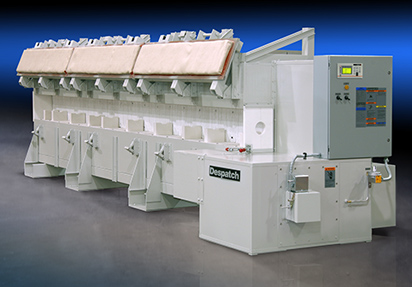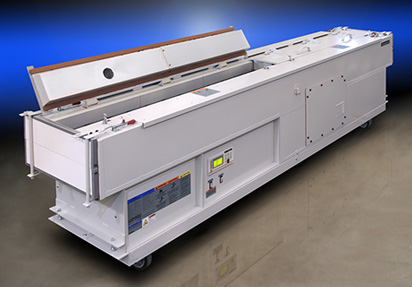While the supply of crude oil is tightening globally, the demand for this resource is peaking. Some analysts expect the demand to peak from 2024 to 2027. That’s putting enormous pressure on oil companies to ramp up production. But boosting production is only possible with the right equipment, given the other challenges facing oil and gas companies. Oil and gas industrial ovens, like Despatch’s PTC Downhole Calibration Oven, can help companies meet oil production goals safely, efficiently and cost-effectively.
“Smart drilling” using the latest drilling technology is the key to boosting oil production and meeting the increased demand for the resource. Technology-driven tools, such as downhole simulation ovens and burst-testing ovens, are critical to increasing oil production cost-effectively for a company. These production workhorses, in fact, are mainstays in many oil and gas production operations. Ideal for well-drilling, completion, and intervention operations, these ovens help boost efficiency and safety while optimizing production output.
The Challenge of Downhole Drilling
Oil and gas companies employ various drilling tools to extract crude oil and petroleum from the earth. Achieving a company’s production goals, however, it depends greatly on equipment uptime and efficient operation. Downhole drilling tools are especially critical for pumping oil from wells continuously.
Downhole drilling tools provide numerous functions, including:
- Video inspections provide a continuous, permanent visual record of the well-casing, screen, or open hole, as well as real-time viewing and detailed inspections of features of interest.
- Geophysical logging involves measuring various physical parameters by lowering a probe or sonde-containing sensors into a well or borehole. Companies can then use the readings to evaluate the well’s geology and construction. (This is also known as electric logging.)
- Natural Gamma Ray Logging measures the amount of emitted gamma radiation as a function of depth, allowing companies to get an accurate “picture” of the nature of the material penetrated by the well.
However, the operational conditions that downhole drilling tools encounter are often harsh and fluctuating, leading to increased failure rates and decreased reliability. Malfunctioning or broken drilling tools can disrupt production, causing bottlenecks. Given the extent of drilling equipment required for well excavation today, such interruptions are not uncommon.
Oil and Gas Industrial Ovens Boost Efficiency and Safety
Oil and gas industrial ovens provide numerous functions for companies, such as burst testing, qualification testing, and calibration of downhole drilling tools, that help safely boost efficiency and safety. These ovens can, for instance, simulate downhole temperature drilling conditions and validate that the tested instruments will work correctly and accurately throughout the run. Plus, you can use the ovens for preheating, thermal cleaning, and curing of coatings on drill joints, couplers, elbows, stators, and rotors.
Despatch offers a variety of oil and gas industrial ovens designed specifically for oil production, such as its PTC Top Loading Oven for downhole tool calibration. This low-maintenance ovens is ideal for calibration of the electronics on the drill tool in the field. It provides consistent, repeatable performance in a small package. Plus, it lets you load heavy equipment into a test chamber by crane while silicone door seals and positive-latching clamps secure the door tightly.
PTC Ovens Offer Long-term Reliability
The PTC Toploading ovens promote long-term reliability in challenging conditions. It features a rugged design that lets you connect multiple units for use with longer tools, a set of fans and controls located below the chamber to minimize floor space, and a UL-listed open control panel. The oven also features an aluminized interior for maximum corrosion resistance, horizontal airflow with adjustable louvers to ensure uniformity throughout the chamber (2.7, 4, 12, and 48 cubic feet), and marinite end caps you can machine to insert instruments, tooling, testing leads.
Standard digital controls on the PTC oven regulate temperatures within tight tolerances and provide high-limit protection. The optional Protocol, 3™ microprocessor-based temperature and high limit controller with a large LCD and real-time clock for auto start capability, provide increased control. The unit’s data-logging functionality supports reporting and analyzing data. Data files are exportable via the controller’s USB port. Maximum temperature for this oven is 260°C (500°F).
Industrial Ovens Help Companies Ramp Up Production
In addition to the PTC toploading model, Despatch also offers front-loading models, higher temperature capabilities, and custom lengths to fit your application. Plus, the company offers a non-magnetic/non-conductive configuration with a fiberglass oven body and structural supports for electromagnetic instrument testing. These ovens come in 12-, 15-, and 24-foot chamber lengths and have a maximum temperature of 180℃ (356℉). Like the toploading model, these ovens can withstand harsh oilfield conditions for many years.
The demand for oil will only increase the next few years, putting pressure on companies to ramp up production. That will be challenging. These companies will need the right equipment to get the job one. Industrial oil and gas ovens, including, downhole simulation ovens and burst testing ovens, will play a critical role in keeping oil flowing freely to meet demand. With help from ovens like Despatch’s PTC Toploading Downhole Oven, these companies can execute the “smart drilling” techniques that drive production to the next level safely and efficiently, boosting profitability.
Image by Shaun Undem from Pixabay








